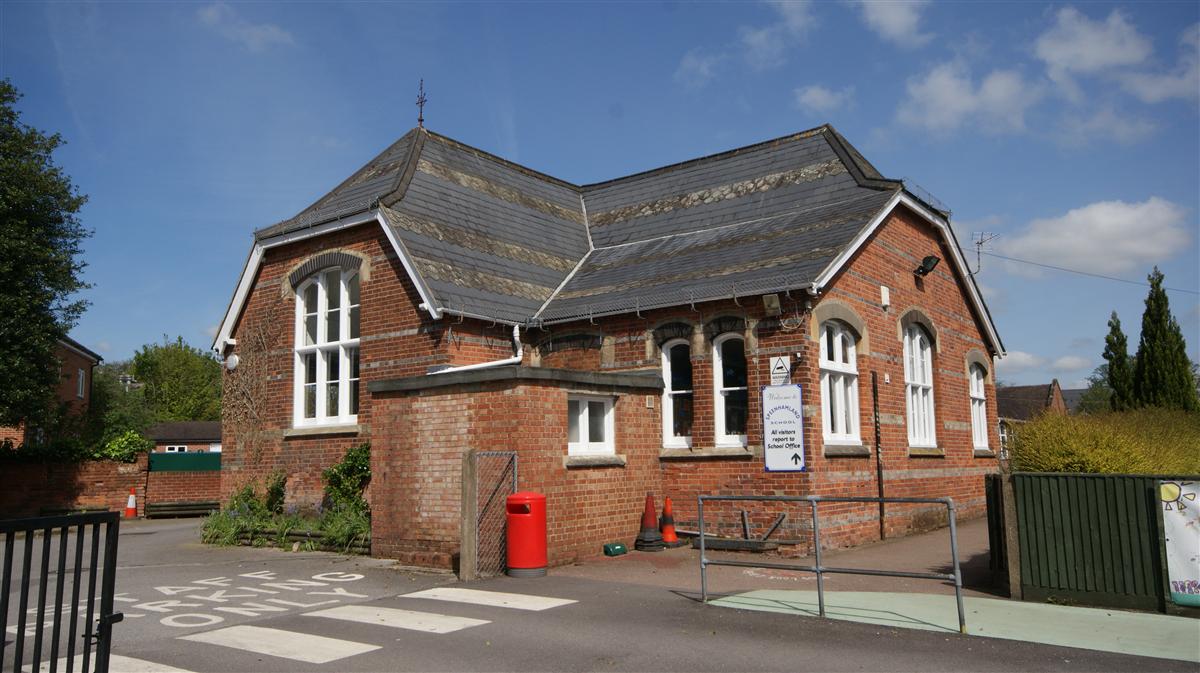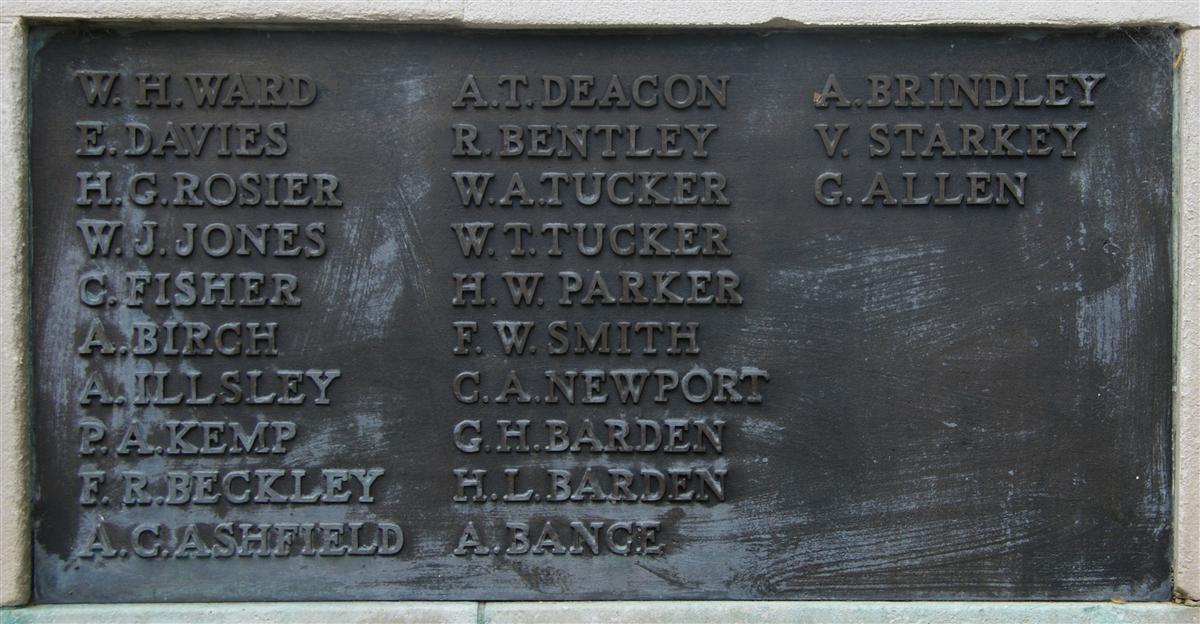Albert Frederick King
Rifleman R/14467 Albert Fredering King, 1st Battalion, King's Royal Rifle Corps

The regimental badge of the Kings Royal Rifle Corps, as used on CWGC headstones. |
James’ wife Rebecca, née Tarrant, was from Chaddleworth; they married in 1873, however, their first child, Emily Eva, was born the year before. They had a further seven children of whom Albert was the youngest. All his surviving siblings were girls: Alice Annie (born 1875), Ada Maud (1878), Elizabeth Ellen (1880), Laura Jane (1884) and Ethel Constance (1893). A further, unidentified child died in infancy.
Albert was educated in the Speenhamland schools, the infants’ in Pelican Lane (Speenhamland Backway at the time) and then St Mary’s behind the parish church of the same name. By the time of the 1911 census, at the age of 15, he had begun his working career alongside his father at Elliott’s joinery. He did not stay with Elliott’s for very long, by the time he volunteered for military service in 1915 he was employed as a milkman.

Speenhamland Infants School, where Albert began his formal eduction. |
He trained with the 6th Battalion of the regiment before being sent to France where he joined the 1st Battalion on 21 January 1916. He was not with the battalion for long before, on 12 February, he was seconded to 170 Company, Royal Engineers on a temporary attachment. 170 Company was one of the tunnelling companies, employed in undermining the German positions in order to place large quantities of explosives under strongpoints. It may be that Albert’s early training as a carpenter/joiner singled him out as a useful man for 170 Company, but it is as likely that his battalion was simply ordered to supply a certain number of men and it was a case of last in, first out.
He spent over a year with the tunnellers, his attachment to them being made ‘permanent’ (according to his records) on 18 November 1916. However, it remained an attachment, he remained a soldier of the King’s Royal Rifle Corps – he was not transferred to the Royal Engineers. He received a boost to his pay when he was awarded 1st Class proficiency pay (an extra 6d a week) in July 1917.
Despite its description as permanent, Albert’s time with the tunnelling company came to an end. In September 1917 he arrived at No 1 Infantry Base Depôt for deployment to an infantry battalion in the field. Infantry Base Depôts typically received drafts of men arriving from the UK and held them until they were satisfied they were ready for service (fit and adequately trained) before sending them to one of the battalions serviced by the Depôt. The inference is that Albert had been back to the UK for some reason; there is nothing on his medical record to show he had been wounded (the most frequent cause of a break in service and redeployment to a different unit). Perhaps he had become surplus to requirements in 170 Company and had been home on leave prior to returning to infantry duties? Whatever the cause, he was posted from the Depôt to his old battalion, the 1st King’s Royal Rifle Corps joining it in the field on 4 October 1917.
He was given leave between 13 and 16 February – not a long time, but it was possible to get home for a couple of days if he chose to do so. The next news of him came in the Newbury paper:
Newbury Weekly News, 4 April 1918 – Local War Notes
Mr and Mrs King, of 18, Westbourne-terrace, Newbury, have been officially informed of the death of their son, Rifleman A K King, King’s Royal Rifle Corps, who received a gas shell wound on March 14th and died in Rouen Military Hospital on March 22nd. He joined the Army in 1915, and went to France two years ago. His age was 22. There are seven daughters, and he was the only boy. The father has worked at Elliott’s Joinery Works for forty years.

Mustard gas victims being led away - a column of blinded soldiers. For most the blindness was temporary, for some a life of darkness had begun. |
However, all was not as it seemed, Albert was still alive when this appeared in the Newbury paper.
He had indeed been gassed (on 13 March) and admitted into a Field Ambulance (despite the name this was a forward hospital facility).
He was not alone in suffering from gas that day:
War Diary, 1st Battalion, King’s Royal Rifle Corps – 13 March 1918
Villers-Plouich At 1am an intense bombardment with gas shells and HE started on FARM RAVINE and VILLERS PLOUICH. Although men wore their gas masks for 6 hours, as soon as they took them off they were gassed. The whole battalion was affected though in the front line Companies only about 4 men in each had to be evacuated. But both the support companies, and the personnel of Bn HQs were badly affected, and by noon scarcely a man of them could see. The Commanding Officer, who in the morning had gone round the line, returned to find the whole road lined with blind and vomiting men, with eyes streaming and swollen. Most of Bn HQrs, and every officer and man of “B” and “D” Coys had to be led or carried out of the line. There was some gas shelling in the evening, but it was nothing like so heavy. Casualties: 7 Officers and 270 OR gassed.
The battalion had been subjected to a bombardment with mustard gas shells. Mustard gas was heavier than air, often liquid, and settled on the ground rather than being dissipated by any breeze. It could hang around for days, certainly more than the six hours the battalion remained in their gas masks. It was not the most lethal of gases in common use (only 2% of mustard gas casualties died) but it was often debilitating with vomiting, blistering skin and swelling (often to closure) of the eyes. A fatal dose would typically take four to five weeks to kill. The other aspect is that it was virtually odourless and its effects took some time to manifest. Consequently men would remove their respirators far too soon thinking the threat had passed. This was probably the battalion’s first experience of such heavy use of mustard gas - some 150,000 mustard gas shells were fired into the Cambrai salient over a period of three days inflicting around 4,700 casualties.
 Albert's name on Newbury War Memorial (middle left) |
The following day Albert was transferred to the 5th General Hospital at Rouen. On or about 22 March he was transferred to the 2nd General Hospital at Le Havre. At this point the paperwork seems to have gone very wrong and the War Office was notified that he had died – hence the newspaper report. On 9 April he finally succumbed to his injuries in Le Havre.
He was buried in grave Div.62.III.C.4 at Ste. Marie Cemetery, Le Havre
Albert was remembered on four local memorials, three survive: Newbury’s Town Memorial and the Speenhamland Shrine, now in St Nicolas’ Church, and the Congregational Church Memorial, now located in Newbury Town Hall. The fourth, now lost, was in Speenhamland School.

